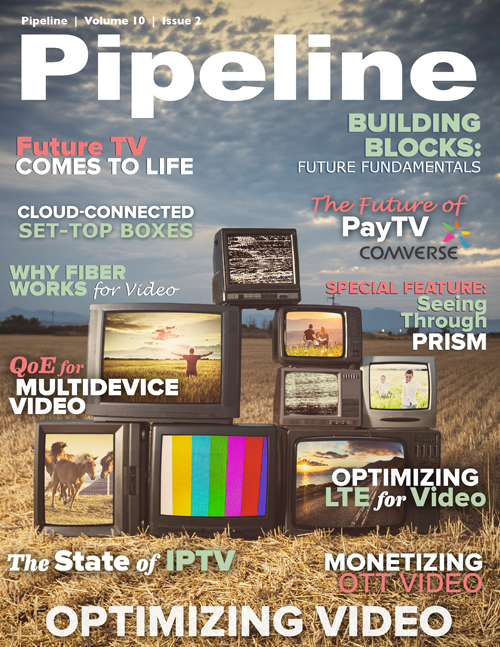Bringing the Future of TV to Life
By: Jesse Cryderman

What does it mean to watch television? Pose this question to five different people and you’re likely to hear five different definitions. That’s because TV is having a bit of an identity crisis—what used to refer to an appointment-like pastime that occurred in living rooms, basements and bedrooms has transformed into an “anytime, anywhere” activity. TV has changed more in the past 5 years than it did in the previous 50, but because “TV” also refers to the means by which we watch—to put it another way, people listen to music, not record players—the term “video” is really more appropriate in this case.
The demand for high-quality streaming video has accelerated the speed at which next-generation mobile and terrestrial networks have evolved, a trend that’s spawned new operational and billing support systems (OSS/BSS) that are required to provision, deliver, manage, and charge for the video experience. A wide variety of video services have untethered consumers from their set-top boxes and homes, and now even live streaming video, once the sole domain of broadcast networks and pay-TV (i.e., cable, satellite, IPTV) channels, is available from over-the-top (OTT) players like Aereo and content providers such as ESPN and ABC (both owned by Disney). Television as we once knew it has gone through a metamorphosis, and so has the video business.
Communications service providers (CSPs) that compete in the video market have a challenging road ahead of them. That’s because the video experience of the future will be more personalized and interactive than before. Systems that once delivered video to a single device type and location (for example, the TV set in your living room) and billed for service on a monthly basis must now accommodate thousands, if not millions, of unique streams, not to mention IP video delivery, multiple-device profiles, mobile optimization, and real-time billing. And user interfaces must be re-engineered to incorporate social networking, employ modern search and recommendation engines and pull video streams from numerous content providers. Meanwhile, transport networks are already overburdened with video traffic, and with new technologies like 4K Ultra HD video just around the corner, this problem will continue for years to come.
How can these demands be addressed in a manner that delivers on both consumer and business expectations? Thankfully, there are numerous solutions on the market to support CSPs in their quest to make the future of video a reality.
The pillars of next-gen video
When it comes to the next stage of video’s evolution, there are five key elements CSPs need to take into account:
Multidevice: “If you don’t have your products on every platform, you’re missing a whole generation,” said Comcast CEO Brian Roberts at the Cable Show in June. Multidevice delivery is table stakes: consumers view video through connected TVs, traditional TVs, mobile devices, the internet, and OTT platforms such as Google TV, Apple TV, Roku, the Nintendo Wii, and Microsoft’s Xbox Live. Ignore any of these and you risk losing a sizable chunk of your potential viewing audience. The customer experience must be seamless from one device or platform to another.Multicontent: The future of video isn’t walled gardens—it’s all-inclusive. Service providers must deliver all types of content under one roof, whether it’s web based, video on demand (VOD), traditional television, live programming, or user-recorded content. All potential video streams must be available to the consumer.
Smart video: The modern search and recommendation engines used by companies like Netflix (and, starting at the end of this year, Comcast) are essential. Further innovations that will typify the future video experience include integration with external ratings sources like Rotten Tomatoes and Metacritic, social sentiment meters and more. Smart video leverages monetization opportunities whenever they’re relevant, such as short-term mobile-video upgrades, off-peak incentives and ad hoc movie packages. Smart-video platforms detect device type and correlate it with location, user profile and network data to optimize each video stream accordingly for the best viewing experience per use case.
Personalization: Compelling video incorporates social-network streams (Facebook, Twitter), location, and user profile and preferences to deliver a personalized experience. Unlike traditional pay TV, which gives a customer essentially one profile, future video services must accommodate numerous dynamic user and device profiles for each account. Think about it: a personal content concierge for each member of the household. In addition, video services can be integrated with home automation, security and, eventually, connected-car services.
Ease of use: Customers request services, order content and engage customer support through numerous channels, so service providers must be equipped to address each case. A customer might begin requesting a service on the internet, then jump to a mobile device to complete the order and, finally, follow up with a phone call. Later on Facebook a friend might suggest a movie to the customer, who would then order it on a mobile device and watch it on his or her Xbox 360 after getting home from work, usually within a 24-hour viewing window designated by the service or content provider. The entire process must be easy and seamless.



















